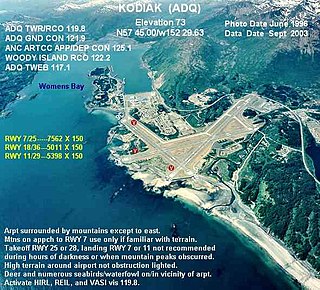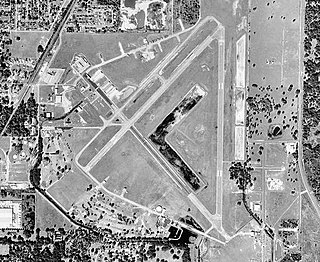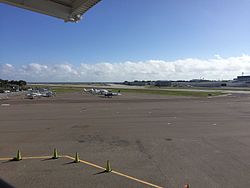
Tampa International Airport is an international airport six miles (9.7 km) west of Downtown Tampa, in Hillsborough County, Florida, United States. The airport is publicly owned by Hillsborough County Aviation Authority (HCAA). The airport serves 93 non-stop destinations throughout North America, Central America, the Caribbean and Europe across multiple carriers.

St. Pete–Clearwater International Airport is a public/military airport in Pinellas County, Florida, United States, serving the Tampa Bay Area. It is right on the northeast municipal boundary of Pinellas Park, 9 miles (14 km) north of downtown St. Petersburg, 7 miles (11 km) southeast of Clearwater, and 17 miles (27 km) southwest of Tampa.

Tallahassee International Airport is a city-owned airport five miles southwest of downtown Tallahassee, in Leon County, Florida, United States. It serves the state capital of Florida, and its surrounding areas; it is one of the major airports in north Florida, the others being Pensacola, Northwest Florida Beaches, and Jacksonville. Despite its name, it does not yet service any international destinations.

Peter O. Knight Airport is an airport on Davis Islands, five minutes from downtown Tampa, Florida. Built as a Works Progress Administration project, it was Tampa's main airport from 1935 to 1945, and is still used by general aviation operators today because of its proximity to the central city. The airport was named for prominent attorney and businessman Peter O. Knight, namesake of Holland & Knight.

United States Coast Guard Air Station Clearwater is the United States Coast Guard's largest air station. It is located at the St. Petersburg-Clearwater International Airport in Clearwater, Florida and is home to nearly 700 USCG aviation and support personnel. As of March 2021, there are ten MH-60T Jayhawk helicopters and four HC-130H Hercules aircraft assigned to CGAS Clearwater. Also on static display is USCG 1023, a restored Grumman HU-16 Albatross.

Daytona Beach International Airport is a county-owned airport located three miles (5 km) southwest of Daytona Beach, next to Daytona International Speedway, in Volusia County, Florida, United States. The airport has 3 runways, a six-gate domestic terminal, and an international terminal. Daytona Beach is the headquarters of Embry-Riddle Aeronautical University.

Kodiak Benny Benson State Airport is a public and military use airport located four nautical miles southwest of the central business district of Kodiak, a city on Kodiak Island in the U.S. state of Alaska. The airport is state-owned and operated by the Alaska Department of Transportation & Public Facilities (DOT&PF). It is home to the co-located Coast Guard Air Station Kodiak and a hub for Servant Air. On April 11, 2013, the Alaska State Legislature passed SB31, which renamed the facility "Kodiak Benny Benson State Airport," in honor of the designer of the Alaskan flag.

Miami-Opa Locka Executive Airport is a joint civil-military airport located in Miami-Dade County, Florida 11 mi (18 km) north of downtown Miami. Part of the airport is in the city limits of Opa-locka. The National Plan of Integrated Airport Systems for 2011–2015 called it a general aviation reliever airport.

Addison Airport is a public airport in Addison, in Dallas County, Texas, United States, 9 mi north of downtown Dallas. It opened in 1954 and was purchased by the town of Addison in 1976. It is home to the Cavanaugh Flight Museum.
North Perry Airport is a public airport in the City of Pembroke Pines, 5 miles (8 km) west of the central business district of Hollywood, in Broward County, Florida, United States. It is also known as Hollywood North Perry Airport, hence the HWO codes. The airport is owned by the Broward County Aviation Department. It is a general aviation airport devoted to private and business light aircraft activity.

Renton Municipal Airport is a public use airport located in Renton, a city in King County, Washington, United States. The airport was renamed Clayton Scott Field in 2005 to celebrate the 100th birthday of Clayton Scott. The airport's northern boundary is Lake Washington and the Will Rogers–Wiley Post Memorial Seaplane Base. Renton Airport has a floating dock and a launching ramp for conversion from wheeled landings to water takeoffs and landings.

On January 5, 2002, Charles J. Bishop, a high-school student of East Lake High School in Tarpon Springs, Florida, United States, stole a Cessna 172 light aircraft and crashed it into the side of the Bank of America Tower in downtown Tampa, Florida. The impact killed the teenager and damaged an office room, but there were no other injuries.

Lakeland Linder International Airport is a public airport five miles southwest of Lakeland, in Polk County, Florida. The Federal Aviation Administration (FAA) National Plan of Integrated Airport Systems for 2017–2021 categorized it as a national reliever facility for Tampa International Airport. The airport has a Class 1 Federal Aviation Regulation (FAR) Part 139 operating certificate allowing passenger airline flights.

Zephyrhills Municipal Airport is a public use airport in Pasco County, Florida, United States. It is owned by the City of Zephyrhills and located one nautical mile (2 km) southeast of its central business district. This airport is included in the National Plan of Integrated Airport Systems for 2011–2015, which categorized it as a general aviation facility.
W. K. Kellogg Airport is a city-owned, public-use, joint civil-military airport located three nautical miles (6 km) west of the central business district of Battle Creek, a city in Calhoun County, Michigan, United States. The airport is accessible by road from Helmer Road, and is located near I-94. It is included in the Federal Aviation Administration (FAA) National Plan of Integrated Airport Systems for 2017–2021, in which it is categorized as a regional general aviation facility. It is also known as W. K. Kellogg Regional Airport.

Northeast Florida Regional Airport, is located approximately four miles (6 km) north of historic St. Augustine, in St. Johns County, Florida, United States. NFRA serves as a key connection point for air travel in the Northeast Florida region. It is a public airport managed by the St. Johns County Airport Authority on behalf of the citizens of St. Johns County. Airport facilities include both commercial and general aviation terminals.
Tampa Executive Airport, formerly known as Vandenberg Airport, is located in unincorporated Hillsborough County, Florida, six nautical miles east of the central business district of Tampa. VDF covers 411 acres of land.

Lt. James Albert Whitted, was an American aviator from St. Petersburg, Florida. During his career, Whitted was an engineer, an instructor at the Naval flight school and ran a commercial air service business. Whitted was killed in a plane crash near Pensacola, Florida in 1923. The Albert Whitted Airport in St. Petersburg was named after him in 1928.



















